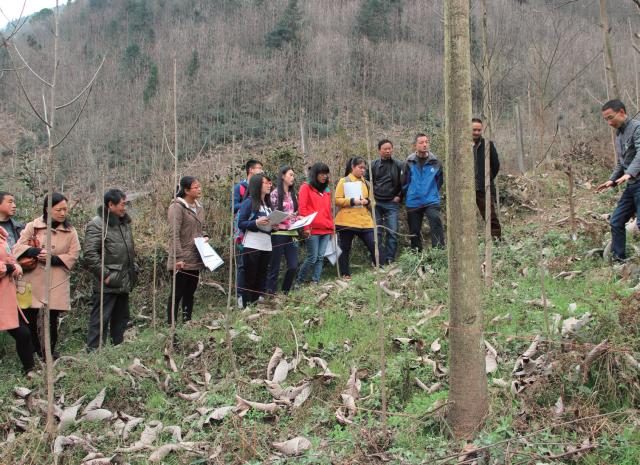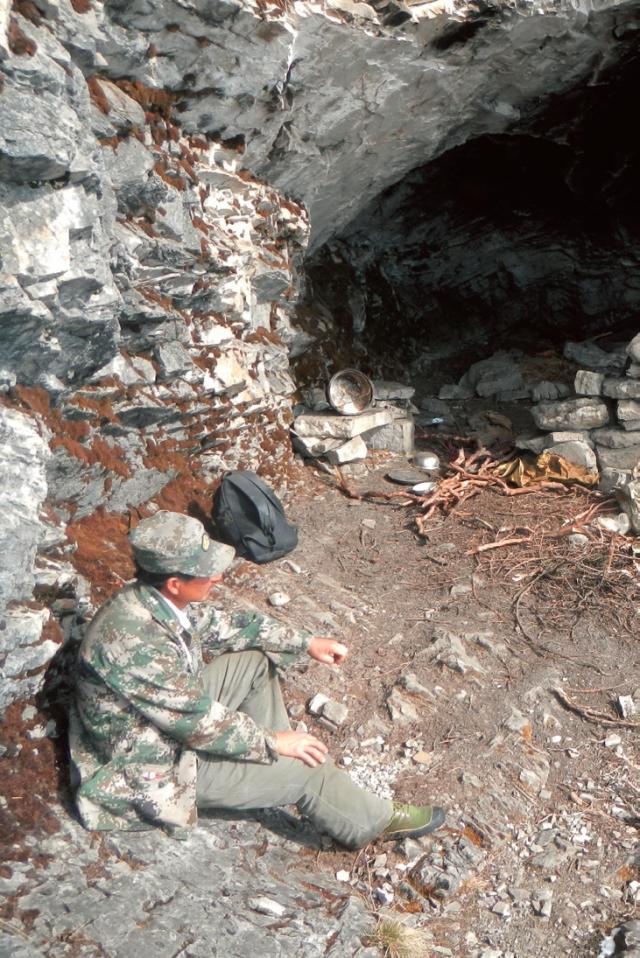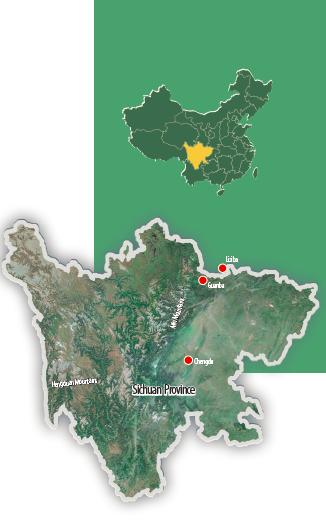For environmental protection efforts to succeed, local communities must be on board.
Otherwise, authorities are inviting a war between conservationists trying to protect nature and the local residents who resort to exploiting it to make a living
On a humid day in late April, Li Xinrui trekked deep into the Guanba valley in northwestern Sichuan Province to tend to his cluster of beehives. Several other local beekeepers maintain their apiaries in this lush glen. Spring is a crucial time for bee colonies – the bees are breeding and may start to swarm, so Li needs to check on them often as the weather warms.
Li has only been a beekeeper for a handful of years, just like other apiarists in Guanba. The practice wasn’t introduced into the region until 2009. A series of crackdowns on logging, hunting and overfishing had shut local residents out of the industries that had been putting food on their tables for decades. In this battle of economic development versus environmental conservation, the development side was losing, so its members struck back with guerilla tactics – illegal poaching and logging – in order to make a living. Once enforcement tightened, they needed a new way to sustain themselves legally.
A domestic NGO stepped in and instituted a community program that made it possible for these warring sides to make peace. The organization taught locals beekeeping skills, giving them a business that helped to fill the financial void. The new enterprise provided them with the motivation to protect the environment as well, because environmental conditions directly affect their source of income.
As China wraps up the first year of its national park pilot project, which will lead to the establishment of the country’s first true national park system by the end of 2017, community-based development programs like Guanba’s will only become more important. More land will be protected more rigidly, preventing more locals from using its resources for their economic gain. With the establishment of each new national park or protected area, authorities need to figure out the right way to involve the local community in its preservation, while at the same time helping its members develop an alternate, sustainable livelihood.
Sweet Success The Guanba valley is located in Sichuan Province’s Pingwu County, about 300 kilometers from the provincial capital, Chengdu. Nature reserves that house dozens of giant pandas surround the valley, making Guanba an important migration path for pandas traveling between them. Roughly six or seven pandas inhabit the valley itself, according to a 2012 national survey. Guanba also serves as a source of drinking water for the 800-900 villagers who live in the region.
As was common in most of China’s mountain regions, loggers, poachers and fishermen milked the valley of its resources in the 1980s and ’90s. The subsequent catastrophic flooding of the Yangtze River moved the central government to action. It launched the Nature Forest Conservation Program (NFCP) in 1998, which instigated a widespread logging ban to reduce flooding, and also started the confiscation of hunting rifles to put an end to illegal hunting. After the program spread throughout the region, its environmental situation noticeably improved. The logging ban was most strictly enforced in the Yangtze River’s upstream regions, including Sichuan Province.
Deprived of their main source of income and lacking sufficient government subsidies, timber-dependent residents like Guanba locals were hard pressed to find an alternate way to earn money. This pushed local villagers to make ends meet by hunting illegally, covertly cutting down lumber and gathering valuable mushrooms and herbs, often at the expense of the panda’s habitat. In spite of the NFCP, threats to conservation remained.
Real change arrived in 2009, when the environmental NGO Shanshui Conservation Center came to Guanba looking to advance the local community’s economic development with the ultimate goal of protecting the environment. Under Shanshui’s guidance, the locals formed a beekeeping cooperative so they could sell honey as a new source of income. They also organized teams to patrol the valley regularly, thus combating illegal poaching and logging in the area. These conservation efforts have already sparked a resurgence of local wildlife.
Apart from the giant panda, the valley is home to populations of snub-nosed monkeys, wild boar, tufted deer, golden pheasants and the antelope-like takin.
To make Guanba’s honey as commercially successful as possible, Shanshui invited a commercial partner to help the locals brand their organic product, calling it Panda Honey, and explore market opportunities.
In accordance with Shanshui’s strict requirements, Panda Honey beehives house indigenous honey bees and are set up a minimum of three kilometers away from human settlements in order to ensure that all of the flowers from which the bees collect nectar are free of fertilizers. To guarantee the honey’s quality, the whole production process of the beekeepers who work with Shanshui is monitored by the NGO and its partners. Because of the stringent standards, the NGO’s commercial partner buys the honey from the locals for more than 100 yuan (about US$15) per kilogram, which is 20 percent higher than the average market price of a similar product, according to Chen Yuanming, Panda Honey’s marketing officer. “With a stable income from harvesting honey, some local villagers no longer need to resort to hunting or digging up mountain herbs, and they have also stopped herding, something that can lead to the pollution of water sources,” Chen said. Finally, the commercial partner sells Panda Honey to the public, but it does not retain 100 percent of the resulting income. “Every year, 10 percent of the income from Panda Honey sales are returned to the local community for things like new beekeeping equipment, better technology for wildlife monitoring, supplies for patrolling activities, or simply for the construction of local village infrastructure,” Chen added. While Panda Honey remains a niche brand, it is in the process of being certified as organic for the European market, Chen said, and the partner company has plans to export their product to Japan as early as this fall.
Over the past seven years, Guanba’s number of beehives has risen from just a few to more than 500. In 2013, the honey-producing cooperative was officially transferred to the village. The cooperative’s 10 members and 34 shareholders, all of whom are Guanba locals, elected Li Xinrui as chairman. The new organization has set up a board of administration, nailed down its rules and regulations, and holds regular meetings for its members once each season.

Experts invited by Longxi-Hongkou National Nature Reserve in Sichuan Province teach locals how to patrol and set up cameras to monitor the protected region, March 14, 2015

Villagers find a campsite left by poachers on Jiuding Mountain, Sichuan Province, December 5, 2015
While it still produces a limited amount of honey under the Panda Honey name, the cooperative has also launched its own local brand, Zangxiang Tumi (which translates roughly to Tibetan Fragrant Indigenous Honey), in order to explore both the online and offline market.
“A big problem is that normally, once the funding from NGOs like Shanshui stops, things fall apart,” Li said, referring to similar community development programs. “So to achieve long-term results, we created our own brand to try some incentive marketing methods to keep up our progress. So far our cooperative can support itself, and the dividend yield for our shareholders was 40 percent [of market price] in 2013 and 2014, then 80 percent in 2015.” Li, a young man in his early 30s, believes honey production could become a sustainable industry for both the development of his village and the environment around it.
Guanba villagers also started working to protect their local river, to similarly mutually beneficial results. According to Qiao Liang, another village leader, there used to be a large number of local catfish called shipazi in the river, but because they were considered a Sichuan delicacy, their market price recently shot up to over 1,400 yuan (US$214) per kilogram and overfishing quickly decimated their numbers. “Both villagers and outsiders would use poison or electricity to catch shipazi, a species listed as protected by the provincial government,” Qiao said.
“But since we set up patrol teams in 2009 and stationed some cameras to monitor the activity of both animals and humans, we have caught quite a few people fishing illegally.” Starting in 2013, Guanba residents have periodically released some shipazi fry into the river, which has spurred a significant revival of the fish’s population.
“To inspire other villagers to protect [the environment], we are considering catching and selling a small portion of the shipazi population after this year’s breeding season, then distributing the profits among the villagers so that everyone can see the effects and benefits of conservation,” Qiao said. He added that Guanba is working on other promising industries to supplement the income from the beekeeping cooperative, including walnut cultivation, planting valuable herbs and, in the long run, eco-tourism.
“Spending about 10,000 yuan [US$1,500] on shipazi fry brings us more than 500,000 to 600,000 yuan [US$76,300-91,600] in profit, and more importantly, the hidden benefit of our conservation efforts is that the fish in our river is a sign of our healthy natural environment, which can further attract tourists to come and visit our region,” Qiao explained.
His words are reminiscent of a quote of Stuart Pimm’s, a professor of conservation ecology at Duke University: “If the local people do not see a benefit of local conservation, then whatever the laws are, they are going to be ineffective.”

Snub-nosed monkeys scamper through a forested area near Longxi- Hongkou National Nature Reserve, February 25, 2015
Group Goals Past experiences in China and other countries have proven time and time again that displacing local communities from their traditional lands to create natural reserves, restricting access to resources within those reserves and then providing the communities little or no compensation can make local residents hostile towards conservation groups and their efforts. This often leads to conflict. Community members feel backed into a corner, so they go against the established rules and harvest and hunt illegally. “Local people have a basic stake in the land, their livelihood is not expendable, and any management solution must also consider their interests, knowledge, culture and cooperation,” wrote Anthony Sinclair and George Schaller in the foreword to the book Wild Rangelands: Conserving Wildlife While Maintaining Livestock in Semi-Arid Ecosystems. “Ideally, communities should take the initiative in protecting and managing their own resources: conservation ultimately depends on their goodwill and participation.” The Guanba villagers’ goodwill is now very clear. In Guanba, the forests span over 133 square kilometers. Because the forestry administration doesn’t have enough staff to patrol the entire region, locals set up their own community patrol teams. The enhanced supervision has cut down on illegal activities within protected areas. Now, Guanba residents do not split the annual subsidies they receive from both the central and provincial governments to compensate for the economic losses caused by the protected forest area, as most other communities do. Instead, they use the money to pay for their patrol teams.
There are about 60,000 community conservation programs in China, with about 300 of them located in Sichuan Province. Guanba is a fairly successful example. Many of the country’s other programs only exist on paper or in theory; most have yet to actually execute a project or secure funding. The reason the program worked in Guanba was due to the community members’ drive; they were the key motivating force behind the conservation project, according to Feng Jie, the Shanshui Conservation Center program officer in charge of the Guanba initiative. “The limited annual government subsidies given to compensate for protected forests doesn’t even come close to meeting the real losses villagers suffer from being deprived of their livelihoods, so making the community benefit directly from conservation efforts can stir their ambitions,” Feng said. “In Guanba’s case, the honey, fishing and walnut industries are all closely linked with [the area’s] water sources and forests.” Guanba residents have stopped thinking of conservation as something that takes cash out of their wallets; now they view it as a money-earner.
Economic development and environmental protection do not have to face off on opposing sides. Sometimes they can work together. An ideal community conservation model would be one that creates this sort of mutually beneficial situation, while at the same time being stable and sustainable. Guanba is close, but its honey cooperative does not produce enough to support all of the villagers. Locals hope that through the addition of other endeavors, such as walnut cultivation and cold water fishing, they will be able to sustain themselves while still protecting the environment.
Finding Balance One of the best examples of an ideal configuration is the setup in another Sichuan Province village: Liziba, a town of 243 households located about 140 kilometers northeast of Guanba. While Liziba is technically located in Sichuan, it is under the administrative domain of the Baishuijiang National Nature Reserve, which is affiliated to Gansu Province.
Just like Guanba, Liziba suffered serious deforestation and poaching in the 1990s. Unlike Guanba, Liziba also suffered at the hands of a vengeful Mother Nature. Unprecedented floods pummeled villagers in the rainy season, and climate change wreaked havoc on local tea crops, bringing down one of the village’s pillar industries. Fed up with the environmental chaos, local resident Ren Huazhang, with support from the local government and Baishuijiang, organized a patrol team made up of 20 community members to crack down on illegal loggers and poachers.
Over the following decade, the grassroots project paid off. “Thanks to the shifting of villagers’ mindsets, we stopped activities that were destructive toward nature,” Ren told NewsChina. “And as the forested areas’ environment and water quality improved, the quality of our tea improved as well.” Ren, now Liziba’s Party secretary, added that this has meant more money in villagers’ pockets: “Our tea now has a good regional reputation, and our sales have increased.” Liziba tea farmers collect and process tea leaves from late March until early October every year. According to Ren, the average net income per person in the tea industry is at a stable 7,000 yuan per year (about US$1,100). The village has also established a tea cooperative, and the next step for them is to promote and enhance their own brand to up their price point.
As most of the local residents are well aware of the important role nature conservation plays in the quality of their tea and its sales, they no longer cut down trees or hunt animals in the protected areas. The development of the community has been directly linked with the preservation of its environment.
Grassroots Power China’s community conservation projects vary in structure – some were initiated solely by local residents and some have assistance from local governments or NGOs. NGOs that have worked in Sichuan Province include the World Wide Fund for Nature (WWF), Shanshui Conservation Center, Conservation International, The Nature Conservancy and Global Environmental Institute, according to Yang Xuyi, an official within the province’s wildlife protection office. “We have tried various types of conservation methods, we encourage ways to fully stimulate a community’s participation in the management of protected areas, and our diversified exploration attempts will continue in the future,” Yang told NewsChina.
Yet different situations require different methods. On NewsChina’s 10-day tour of five Sichuan villages, the disparity between certain areas was obvious. For example, some abounded with natural resources, while others had fewer ways to interact with the land. The most critical difference, however, was whether or not a village had strong leaders, like Guanba’s Li Xinrui or Liziba’s Ren Huazhang, who could inspire change, coordinate conservation efforts and eventually help the community become self-sustaining so its business endeavors could continue without assistance from NGOs or government subsidies.
Villages without resources and leaders become trapped, stuck in their dependence on the outside world for help or compensation.
As China looks toward launching its first nine pilot national parks and establishing a new national park system, the local communities living adjacent to and inside the parks also require special attention, said Rose Niu, chief conservation officer at the Chicago-based Paulson Institute, a think tank that is partnering with the Chinese government on the national park initiative. “In fact, the livelihood of the local community should be part of the management agenda for the national parks,” Niu told NewsChina.
Not only should each plan for a new national park or protected area take local communities into account, it should also find appropriate ways to engage the communities in the protection and sustainable use of the national parks' natural resources.
Wang Lei, an adviser with WWF China, shared a similar sentiment with NewsChina. “Be mindful of our traditional Chinese esthetic as shown through our ink-and-wash paintings – despite the beautiful scenery, with its high mountains and long rivers, within the painted scroll there is always a pagoda or a figure, even though it might be small in size,” Wang said. In other words, humans and nature must learn to coexist.


 Old Version
Old Version



